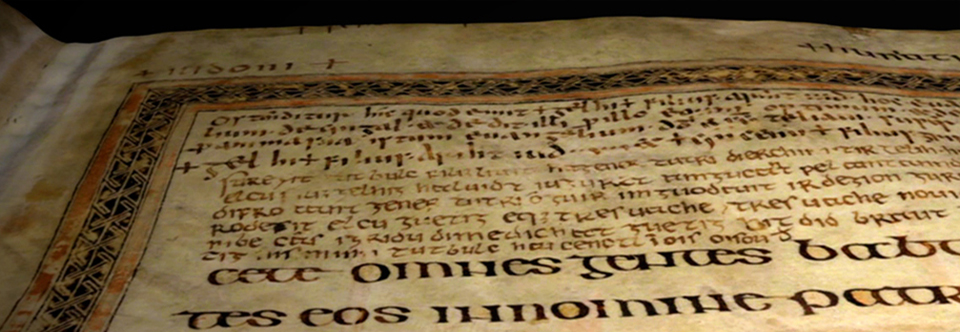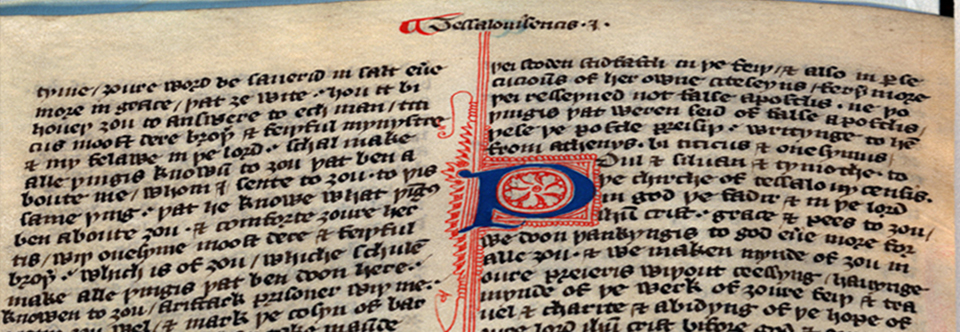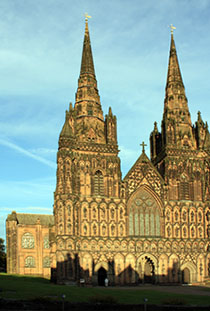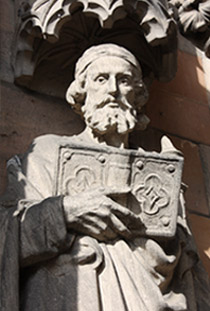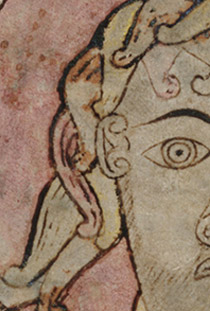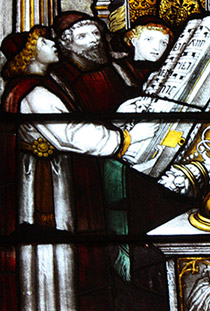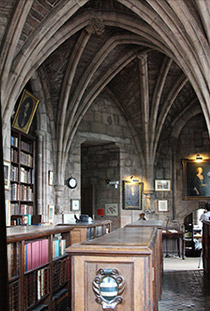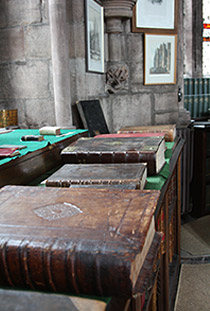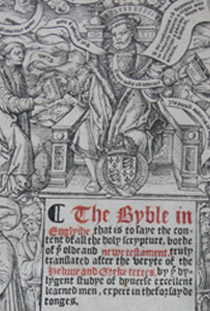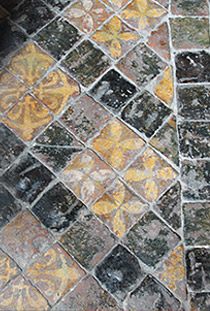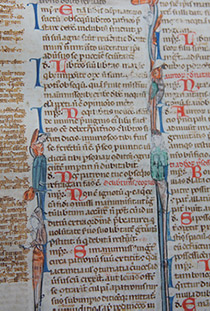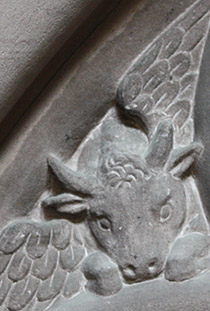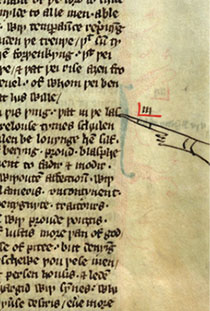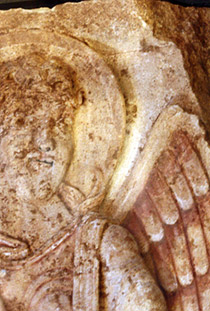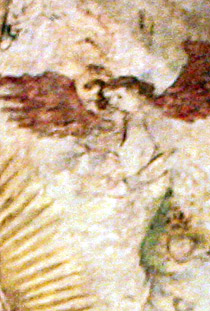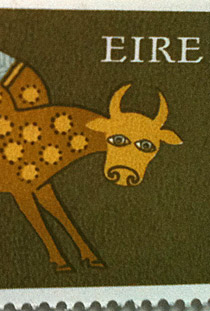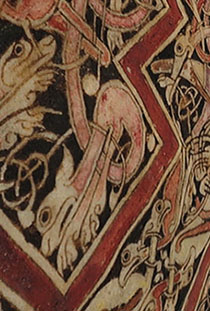Made around 730, the St Chad Gospels is an exquisite blend of cultural influences in the British Isles and beyond. It shows strong correspondences with the Lindisfarne Gospels, which predates it slightly, and the Book of Kells, which it predates by about 70 years. The St Chad Gospels contains the earliest surviving examples of Old Welsh writing.
As an African proverb astutely points out, "It takes a village to raise a child." Well, it took three villages to digitize the St Chad Gospels and Lichfield Cathedral's Wycliffe New Testament: the village of Lichfield Cathedral, my team from the University of Kentucky, and the West Semitic Research Project. I am grateful to the people of all three for making something extraordinary happen. The countless tasks connected to a digitization project are daunting in their own right, but the unpredictable places where those countless tasks go astray (sometimes comically) is where these villages constantly showed their mettle: whether it was the Education and Outreach Officer Jo Burkinshaw finding an industrial grade dehumidifier when the humidity reached a height in the confined area of the server's vestry and halted our work, to Matt Fields and Dan Stanley working out near impossible issues of light diffusion, to our massive shipping crate disappearing and the Vergers—Chris, Cathy, and Simon—helping me in a panicked rush to find it before the crate was reduced to salvaged wood. My favorite, however, was when the person delivering an Amazon order of extension cords, line conditioners, and adapters was not able to find the Cathedral (I still marvel at this one). Through the ingenuity, dedication, and good spirit of the people from Lichfield, Kentucky, and California, we overcame the expected and unexpected and now have these irreplaceable and treasured manuscripts digitally preserved and their images accessible.
First and foremost, I would like to thank Canon Chancellor Pete Wilcox. It is through his desire that these manuscripts receive the scholarly attention that they deserve, trust in me and the project from its earliest stages, and goal to share these important manuscripts with the world that this project had a chance to take root. But Pete's vision is a shared vision at the Cathedral--there is much desire at the Cathedral to share these treasured manuscripts and facilitate scholarly understanding, and with the kind permission of the Chapter of Lichfield Cathedral, the imaging of these two significant manuscripts became possible and happened.
At the Cathedral, the people who we taxed most during our two weeks of imaging were the Vergers: Chris Craddock, Simon Ferguson, Chris Gray, and Cathy Potter. They were always helpful and gracious, no matter the request or how many groups of school children were visiting on those warm summer days. I owe them eternal gratitude. However, not far behind the Vergers was Jo Burkinshaw, who constantly rose far above the call of duty, even soliciting her husband's aid in meeting the need of an industrial grade dehumidifier. I am also most grateful to Pat Bancroft, the Librarian, who provided me with exceptional help, and without whom this project would have unfolded much more slowly. Her wit and energy were irreplaceable.
A remarkable group of people to whom I am deeply thankful became affectionately known as the "babysitters." They were community members who signed up for shifts to accompany us during the imaging of the St Chad Gospels, as representatives of the Cathedral. Some took multiple two-hour shifts. Pete had been concerned that sitting for two hours in the dark while we imaged might prove tiresome, the LED lighting flashing through multiple bands of light time and again. But tiresome was far from the case for these energetic, curious, and engaged folks—during imaging, we had marvelous dialogue. I answered questions and pointed out features of the Chad Gospels. They spoke about their interests in the gospelbook and told stories about the Cathedral and Staffordshire area. My interactions with them became one of my highlights of the project, whether I listened to tales of riding ponies in the field where the Staffordshire Hoard was found or witnessed the joy in the face of Lyneth, one of the babysitters, whose face filled with light when I asked her if she would like to hold the St Chad Gospels when technical difficulties required the removal of the manuscript from the book cradle. The babysitters were an absolute delight (thank you!) and included Diana Arthur, Cheryl Baxter, Anita Caithness, Gay Cox, Margaret Davies, Mary Harris, Adam Johns, Brian Jones, Liz Kendrick, Lyneth Lockwood, Pat Scaife, Clare Townsend, Arleen Trickett, and Ann Waller.
Partial funding for the multispectral imaging required that it proceed quickly. These funds resulted from unfortunate circumstances. Ross Scaife, a well-known scholar of Digital Humanities and Classics, died unexpectedly. He was a Principle Investigators (PI) and sole humanities scholar on a grant from the National Science Foundation (IIS-0535003) called EDUCE (Enhanced Digital Unwrapping for Conservation and Exploration). Ross worked with Brent Seales, Director of the University of Kentucky's Center for Visualization and Virtual Environments, to attempt digitally to unroll Herculaneum scrolls damaged when Mt. Vesuvius erupted. After Ross's death, Brent had become stuck on the digital unwrapping and was trying to find a way to use the remaining money from the grant so as not to lose it. He decided to try to digitize manuscripts. He was working with another Classics scholar, Christopher Blackwell, but Christopher was having difficulties finalizing an agreement for an imaging project. Without Ross, Brent needed a scholar who could put together a digital project. Six months prior, I had spoken with Brent about the potential of using his multispectral imaging system for a project. Brent had been open to the possibility. Needing a backup plan, Brent contacted me. The imaging at Lichfield Cathedral is a fitting way to honor the memory of Ross, particularly with me having recently arrived at the University of Kentucky. Ross is best remembered at the University of Kentucky for his kind heart, generous spirit, and advocacy for the Digital Humanities. His memory lives on in this project.
The other part of the funding for the project came from grants from the University of Kentucky (including my startup funds) and the College of Arts & Sciences. I owe much to them. Without these funds, particularly at crucial moments, this project would not have happened. This funding allowed me to complete major tasks, including traveling to Lichfield to work out a contract and resolve issues for digitizing the manuscripts, from where to image (best place turned out to be the server's vestry) to licensing for images. As part of payment to compensate Lichfield Cathedral for the risks to and stresses on the manuscripts, I proposed a unique aspect of this project: digitizing past images and aligning them to assess how the St Chad Gospels is aging. These images are not included in the CC licensing agreement, other institutes and individuals holding the copyright. To read about this unique aspect of the project, see my article ""Imaging Sacred Artifacts" in the Journal of Religion, Media, and Digital Studies.
But of course most crucially, my funding allowed me to travel to Lichfield to lead the imaging effort. Because the project proceeded frugally, I performed countless functions. For instance, a photographer was not hired and I filled this role, working with the software engineers and approving final decisions about exposure, positioning of lighting, and focus. Furthermore, because ultraviolet light damages vellum, I worked with the conservator during imaging to justify pages that required ultraviolet imaging. This provided us the opportunity to discuss the merits for using ultraviolet light on a page when the manuscript was opened to it. Further funds were needed a year later, when I returned to Lichfield to deliver a lecture and the final images; however, the post-processing was delayed, and I would not receive the images until much later, nearly two years later. When I received them, I discovered 10 gigabytes of images missing and 3D files needing repaired. I led efforts to recover this data, repair 3D files, and add metadata. Then, I secured more funding and return to Lichfield, delivering the final images. For financial support throughout this process, I cannot thank the College of Arts & Sciences at the University of Kentucky enough.
The technical support for the project rested on the shoulders of Matt Fields and Daniel Stanley. Dan wrote the application to capture the 3D data and interface for the multispectral imaging as his master's thesis. Matt and Dan showed constant grace under pressure, and they had me thinking that if I ever return to Antarctica, I would take both of them with me (I did support work for the National Science Foundation in Antarctica for six months). Their ability to meet any challenge, whether it involved the MegaVision camera and its software, networking, or generating images on the fly for quick proofs, was the work of legend. Unfortunately, their fellow computer scientist, Ryan Baumann, did not accompany us to Lichfield, but he has done substantial work generating multispectral visualizations and other images. Christopher and Amy Blackwell were with us for a short time and left before the imaging of the St Chad Gospels. They were friends of Brent, and he invited them to stop by Lichfield in case we needed help setting up the book cradle. Amy, dissatisfied with her life as an attorney, was attempting to be a writer. She had worked on the manual for the book cradle. Amy and Christopher needed to travel to Spain and try to finalize the contract for imaging two Iliads, the hoped for second imaging stop that summer. They brought their two delightful children, Zoe (eight) and Will (five). And finally, special thanks to David Jacobs, senior conservator at the British Library, who brought irreplaceable knowledge to the project.
While this project now resides at the University of Oklahoma, the images of the St Chad Gospels and Wycliffe New Testament still reside (as the first project) in the new, state of the art digital repository at the University of Kentucky. I am grateful to Eric Weig, Technical Adviser & Director of Digital Library Services, and his team for their assistance in bringing this project online as part of the new repository. Special thanks to Michael Slone, a programmer for the digital repository, who through his expertise, inventiveness and attentiveness to detail solved multiple issues with the software for ingesting the data into the new database. But I would like to thank everyone who has played a role in envisioning and making this repository happen. It is a spectacular accomplishment, and I am grateful for present and future support.
While the images for this project are safely preserved, this website was first hosted through the College of Arts & Sciences (as part of the dynamic access to the data which resides in the digital repository). I want to say a special thanks to Christian Ecker, Director of A&S Computing, for his and his group's expertise and work on the site. I am particularly grateful to Noah Adler (who solved countless technical issues), Charlie Campbell, and Scott Horn.
In 2014, I received a grant from the West Semitic Research Project (University of Southern California). This grant included training in Reflectance Transformation Imaging (RTI) and loan of equipment for a project. I captured dry-point glosses and the state of pigment in the St Chad Gospels, some of the results (including previously unknown dry-point glosses) available in the RTI Gallery. Special thanks to Marilyn Lundberg, Ken Zuckerman, and Johnna Tyrrell for helping me to solve technical issues from afar during the imaging. This grant also allowed me to capture various medieval manuscripts at the National Library of Wales, Aberystwyth, and early Christian stone carvings in Ireland. The work was further supported by grants from the University of Kentucky's College of Arts & Sciences. Special thanks to Canon Chancellor Anthony Moore, who like Pete, desired to promote scholarship and share the treasured St Chad Gospels with the world. Finally, heart-felt thanks to Lichfield Cathedral's librarian Clare Townsend, whose knowledge, helpfulness, and cheerfulness makes working at the library a pure joy.
Finally, and perhaps most importantly, I wish to thank Mark Kornbluh, Dean of the College of Arts & Sciences at UK. His support throughout this project has been immense. Behind the scenes, Mark has made much happen that otherwise would not have occurred or been possible.
Now, this website resides securely at the University of Oklahoma. Many thanks to Jason Sherman for his expertise and work in transitioning the site from Kentucky to Oklahoma. Special thanks to Kyle Harper, Senior Vice Present and Provost, and Rick Luce, Dean, University Libraries, for supporting the digital humanities and infrastructure that makes projects like mine possible.


